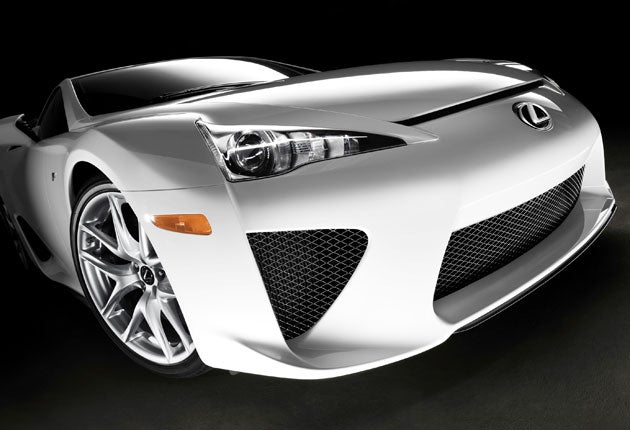Lexus LFA
This £340,000 supercar is built for the race track. But there is method in the Lexus madness

Your support helps us to tell the story
From reproductive rights to climate change to Big Tech, The Independent is on the ground when the story is developing. Whether it's investigating the financials of Elon Musk's pro-Trump PAC or producing our latest documentary, 'The A Word', which shines a light on the American women fighting for reproductive rights, we know how important it is to parse out the facts from the messaging.
At such a critical moment in US history, we need reporters on the ground. Your donation allows us to keep sending journalists to speak to both sides of the story.
The Independent is trusted by Americans across the entire political spectrum. And unlike many other quality news outlets, we choose not to lock Americans out of our reporting and analysis with paywalls. We believe quality journalism should be available to everyone, paid for by those who can afford it.
Your support makes all the difference.Shut your eyes and think of a Lexus. What do you see? And what do you hear? My guess is something smooth, glossy, trimmed in sumptuous leather and wood, making almost no noise and oozing luxury. It might even be a hybrid, adding a social conscience to the sybaritism.
I have just been driving a Lexus, but it is not quite the same deal. In fact it shrieks like a Formula One car. If the recently-launched Lexus IS-F stretched the brand beyond any expected elastic limit with its thunderous V8, nailed-to-the-road ride and competition-car detailing, then the car you see here surely snaps the rubber band. This car is the Lexus LFA, it costs a scarcely-believable £340,000, and I can't imagine many buyers of an LS600h (the current ultimate in cosseting Lexus limos) instantly craving an LFA for their garage. In fact, if they drove one on a track I can almost guarantee a coronary after the first bend.
What can Lexus be thinking of? Actually, it makes sense. Lexus thus far has been an incomplete brand. Audi keeps winning Le Mans. BMW once had its M1 supercar, raced by Formula One drivers. Mercedes-Benz has its new SLS and had the SLR McLaren, Jaguar had its XJ220. To add a bonkers supercar to the curriculum vitae is a rite of passage.
And the Lexus LFA very possibly tops the lot. Just 500 of them will be made, each a sculpture in lightweight carbon fibre, none of them turning a profit for the parent Toyota company despite the price. So why make it, apart from the obvious reasons of kudos and halo-effect? Because lessons learnt from the carbon fibre production process will filter through to Toyota's family cars of the future, cars which may well have carbon-fibre structures if they can be made cheaply enough. Carbon fibre is very light, and cars must become lighter to meet future fuel-efficiency targets.
That's the sensible part. Now the part that assaults the senses, beginning with the engine. Designed in collaboration with Yamaha, it's a 4.8-litre V10 set well back behind the front wheels; it's able to produce 560bhp and it can run to 9,000rpm. All this energy is channelled through a six-speed, paddleshift-controlled, sequential gearbox. This and nearly every other LFA component is bespoke, with just the air-conditioning unit and the mouse-like sat-nav control borrowed from other Lexi.
This is a car which celebrates its unusual construction technique rather than trying to pretend it is really formed from sheet metal. You can tell by the way the ridges and scoops are formed, especially those next to the rear side windows: metal doesn't do that. Few would call the LFA beautiful but it does have an air of menace and some neat detailing, such as the trio of tailpipes and the latticework of air vents beneath the slender rear lights.
Inside, the way the dashboard tucks under itself is more 1950s Americana than post-millennial supercar, while the aluminium air vents, pedals and switchgear ooze racecar-workshop vibes. It's all beautifully wrought and there's still plenty of leather, including handgrips on the steering wheel which make it look like handlebars.
So I'm at the Nürburgring Grand Prix circuit, belted in. I press the starter button on the steering wheel, triggering an aural eruption from under the bonnet. A light tap on the right-hand paddle in to first gear; the left-hand, downshift paddle's action is deliberately firmer. Trickle out of the pitlane, into second, then foot hard down. Good grief. The response is extraordinary. It helps that the LFA is set to Sport mode, which compresses the redundant-on-track, sub-5,000rpm part of the rev-counter scale and sharpens the engine's sinews to snapping point, but even in this mode the gearshifts aren't violent, just very fast.
First fast bend, and the nose darts in so sharply it feels as if the rear tyres have lost their air. No Lexus, not even the IS-F, has behaved like this, and it's a bit of a fright. A few bends later, though, you forget that hyperactivity because once settled into a bend the LFA is pure joy. You can slither its tail at will, you can place it to perfection, you can throw it around and its engine screams its enjoyment at every turn. The beast is not a beast at all; it has instead, as chief engineer Haruhiko Tanahashi happily quotes from Tennyson, "the roar of an angel".
On the road it is not quite so good, its gearbox clunking, and slipping its clutch too much when you're ambling, especially in auto mode. But even that criticism doesn't cool Mr Tanahashi's love of his creation. "If I go to heaven, it will be in this car," he says.
Join our commenting forum
Join thought-provoking conversations, follow other Independent readers and see their replies
Comments